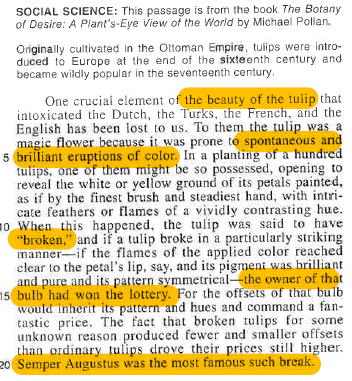Today's Challenge: Commas!
Commas are by far the most assessed form of punctuation on the ACT! The more you know about the comma rules, the better your score will be. Here's a great example that you will see over and over again. What's the right answer?
1
2
New comment Sep 14

Reading Section: Multiple Choice Tips
Hi everyone! I just wanted to share a few tips I use to help make answering multiple-choice questions on the reading section of the ACT a bit easier. 1. FORMULATE YOUR OWN ANSWER FIRST: After you read a question, try to come up with your own answer before you review the options they give you. This can help you immediately eliminate some options that don't align with your understanding of the text. 2. BEWARE OF TRICKS: Remember that many questions will try to trick you by including two answers that both SEEM correct. Keep in mind that the wrong answer will either be too BROAD, too NARROW, or NOT TRUE for that section of the text. Read each option carefully! 3. DON'T OVER-COMPLICATE THINGS: Don't try to mentally argue or add to an answer choice—use only what the choice provides (In other words, if you find yourself saying, "Well, if I look at it this way, it makes sense..." it's probably not correct!). 4. REMEMBER CONTEXT: Some questions may refer to the main idea of only a few specific lines, while others may ask you about the main idea of the entire passage. Make sure your answer reflects the proper context of the question. For example, if a question asks about "the main purpose of the fourth paragraph," your answer should address only the purpose of the fourth paragraph, not the entire passage. Let me know if you would like to see specific examples where these tips may apply! I'd be happy to share a few practice problems and walk you through the process of selecting the best choice.
1
1
New comment Sep 12
ACT Reading - Practice Strategy: READ OUT LOUD!
Remember that you're trying to get better. And practice shouldn't be frustrating as you bang your head against the wall, over and over again. So...if you're practicing ACT reading, why not read the passage OUT LOUD? It's not embarrassing, because you're the only one in the room. OK - if someone else is in the room, whisper or move your lips as you're reading. Time yourself reading "out loud," and let that be the standard for your initial enlightened skim of the passage. Here's what I mean: let's say you read a social science passage out loud, and it takes you 3 minutes and 34 seconds to read the whole thing. You read much more slowly if you're reading out loud and focusing on every word, right? So you shouldn't take more than 3:34 to read the passage in your head. The key to translating what you do out loud to what you will do in the actual test is ACTIVE reading. I use the underlining and highlighting functions on Adobe to help me to remember where key words and phrases are located in the passage, and so should you. Better yet - why not print out the reading passage and highlight/underline it yourself? This is definitely worth a shot. Post clips of yourself reading a paragraph of your next ACT reading passage below!
0
0
Punctuation Week, Day 1 (Commas)
Hey there Students!! Please find the Day One video about nearly everything you need to know about commas for your next test linked here. Also, if you have encountered particularly tricky comma placement questions in your daily prep, screenshot and post them below!
0
0

ACT Reading TOTD - The "Enlightened Skim"
The tip is that you should never, ever read every word of ANY ACT Reading passage! At least, not as closely as you have been taught to do in school. How can you read for concepts (not content) and still complete the questions in a timely manner? This is where the "enlightened skim" comes in. An enlightened skim is a couple of steps above what you're thinking when you say "skim." Take a look at the example from a recent humanities group session attached below. The goal of the enlightened skim is NOT to highlight important details. That takes time to process, and the first read-through should just get you from Point A to Point B. No - the goal of the ES is to leave yourself "breadcrumbs" in the passage, to avoid having to hunt too long for the concepts. If you're not sure where things are located in the passage after your first read-through, you probably just need to refine your skimming techniques! Remember that you will not have highlighters on the test, so I would recommend underlining, circling, stars beside key concepts. The highlighting just makes it easy to see for our purposes here. What else would you add to this strategy?
0
1
New comment Jul 11

1-14 of 14

skool.com/preptopia-test-prep-536
At PrepTopia, we help high school students improve their performance on standardized tests and parents to navigate the college application process.
powered by


